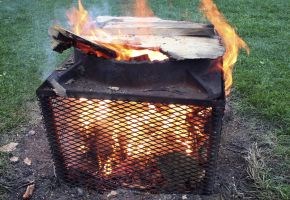Whether or not backyard burning should be allowed, or whether it should be banned entirely has been a hot topic of conversation on and off since public consultation meetings were held last winter.
Acting fire chief Marc Leduc has prepared a report for the priorities committee Wednesday afternoon based on public consultations last winter and what other communities are doing.
The priorities meeting begins at 12:30 p.m. Wednesday July 9 at Tom Davies Square. Following at 4 p.m. is the full city council meeting where the item may be further discussed. For Leduc's report go online to the city's website or call 3-1-1.
“There are two opposing views about open air burning in this community. One view is the long standing tradition of fires for family and social events, which is seen as a benefit of living in this northern community, particularly for those who live on one of our over 300 lakes,” said acting fire chief Marc Leduc, in the report.
“The other view is that we should progress to the 21st century and ban any and all pollution including smoke from wood stoves. Fire Services has no jurisdiction with regard to the smoke from wood stoves inside a dwelling or any other structure."
Leduc said in his report that last October, fire chief Donaldson met with the mayor, Ward 4 Coun. Evelyn Dutrisac and two members of her ward who had concerns regarding the harmful aspects of smoke. They were asking for a complete ban of open air fires in the city core or other built up areas, he wrote.
Donaldson noted that the existing open air burning bylaw is reviewed every two to three years and suggested public consultations. Five public input sessions were held in January to elicit as much public response as possible.
In total, 485 people attended the five sessions. Of these participants, 90 per cent were in favour of retaining the existing by-law, stated Leduc.
During one session attended by Northern Life, it was noted that many who were against banning open air burning still felt a need to protect the quality of life of neighbours through better enforcement of the existing bylaw.
Recommendations from fire services includes:
-allowing day time burning from November 1 to April 30 to allow families who ice fish on city lakes to keep warm
-allowing ceremonial and cultural or festival fires pending an inspection by fire services staff
-increasing the distance of open fires from combustible structures from a minimum of 10 feet to 20 feet
In his report, Leduc stated that the majority of public complaints are related to smoke issues which the department has no jurisdiction over.
The Ontario Ministry of the Environment (MOE) has the jurisdiction for air quality, not the fire department. He noted that it is the recommendation of MOE that fires be set at a minimum of 500 feet from any building.
“If we follow this, there will effectively be no open air burning within the city except for large open tracts of land. It is very clear from the public input sessions that the majority of citizens are not in favour of such a recommendation.”
To address enforcement concerns by the public, fire services has met with the city by-law department to ensure enforcement is consistent across the city, said Leduc. Other cities have been contacted.
-Sault Ste Marie has no open air burning bylaw. They use the Ontario Fire Code to enforce open air burning, as does West Nipissing.
-Espanola is in the process of developing an open air burning bylaw.
-Huntsville and McKerrow have a bylaw similar to what is being proposed.
-Elliot Lake breaks the community into urban and rural sections. Fire size and time of burning is similar to Greater Sudbury. The rural area allows for larger fires, similar to Greater Sudbury's permitting system for agricultural burns.
